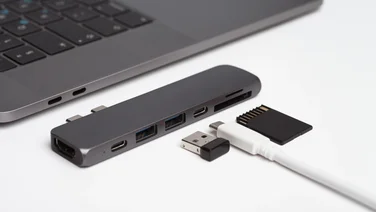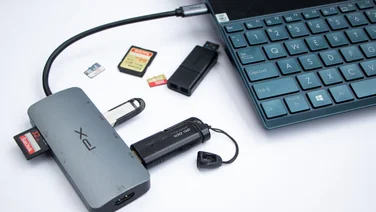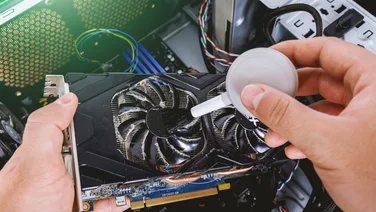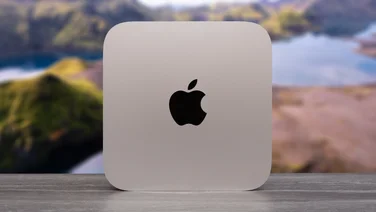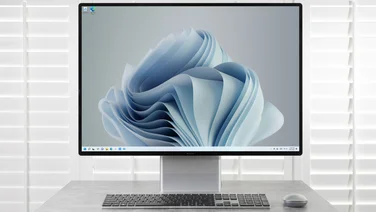To help us provide you with free impartial advice, we may earn a commission if you buy through links on our site. Learn more

- Amazingly compact and well made
- Great value
- Highly efficient
- No USB-A ports
- Nothing else worth mentioning
The Mac mini has, for some time, been the best-value Mac around and the M4 model of this pocket powerhouse remains the cheapest way to get into the MacOS ecosystem. Pair it with a nice big monitor, a decent keyboard and mouse and you have a much cheaper, more capable machine than a 24in iMac and even the base model will give you faster performance than the best MacBook Air.
If you need a simple, tidy little desktop box, there isn’t a better machine around and with all the improvements Apple has introduced with this latest generation, there are even more reasons to buy one. It’s smaller, lighter, more efficient and faster than the previous M2 Mac mini and it comes in at a cheaper price.
Apple Mac mini (2024) review: What you need to know
Despite that lower price, nothing here suggests Apple has been cutting back. We have all the expected upgrades and then some. Not only do you have the choice of more powerful M4 and M4 Pro chips, but Apple is also delivering more RAM in the base model, up to 16GB from 8GB. That’s a change Apple should have made a long time ago.
There’s that new, more compact chassis to enjoy, too – the first time Apple has lavished a redesign on the Mac mini for 13 years. It’s around 42% smaller than the outgoing case, significantly lighter and despite the size reduction, there are more ports and sockets, in more sensible places than before. Thunderbolt 5 ports appear for the first time on a Mac (although only on the M4 Pro model), and the new Mac mini also consigns USB-A to the dust.
Finally, it’s worth noting that Apple claims the Mac mini is now a carbon-neutral product, with an “80% reduction in greenhouse gas emissions across its materials, manufacturing, transportation, and customer use”.
Apple Mac mini (2024) review: Price and competition
Configuration tested: Apple M4 Pro, 48GB RAM, 1TB SSD; Price: £1,999 (inc VAT)
As with the previous M2 Mac mini, there are two models available. The cheapest M4 Mac mini, which costs £599, has a standard M4 chip inside it with 10 CPU cores, 10 GPU cores and a 16-core Neural Engine, accompanied by 16GB of RAM and a 256GB SSD.
The M4 Pro model is more powerful and more expensive, with prices starting at £1,399 for the model with 24GB GB of RAM and a 512GB SSD. The M4 Pro chip has a 12-core CPU, a 16-core GPU and a 16-core Neural engine. There’s no M4 Max version of this mini machine, more’s the pity.
The only other difference between the Pro and the non-Pro models is that the latter has three Thunderbolt 4 ports on the rear, while the former has three Thunderbolt 5 ports.

For this money, whether you buy the standard or the Pro version, the Mac mini is a bargain. The base model is powerful enough for all but the most demanding of workloads and it’s also £400 less than the M2 MacBook Air. It’s by far the most affordable entry point into the Mac ecosystem.
Surely, though, there are alternatives in the Windows universe, I hear you cry (or maybe I’m hallucinating). Well, yes, there are and here’s one I spotted:
You can pick up the Minisforum 790UM with 32Gb of RAM, a 1TB SSD and an AMD Ryzen 9 7940HS CPU powering the show for £539. This won’t quite be able to match the M4 Mac mini for horsepower and certainly not for looks but it comes close, it’s easy to upgrade yourself and you get a lot more storage and RAM as standard.
Apple Mac mini (2024) review: Design
From a practical and aesthetic standpoint, there’s no denying that the design of the new Mac mini is lovely. Although it’s taller than the old Mac mini design, the new one occupies a far smaller footprint on the desk. It’s compact enough that you can grasp it by the base in one hand and it’s just small enough that could pop it in a large jacket pocket. The bulge and the weight, however, means that’s not a practical thing to do.
It measures 127 x 127 x 50mm (WDH) versus 197 x 197 x 36mm (WDH) and it’s much lighter than the previous Mac mini at 0.67kg for the M4 (0.73kg for the M4 Pro) versus 1.18kg (1.28kg for the Pro). From someone who carries a Mac mini to and from work every day, let me tell you, this is a major step forward.
It’s not just the size and weight of the thing that brings a smile to my face, either. I’m also very happy about the positioning of the ports and sockets. You now have two USB-C 3 ports on the front to the left-hand side and the 3.5mm headset jack has moved to the right-hand side. For those emergency moments when your Bluetooth headphones run out mid-video call, that’s going to be a big help. No more fumbling around at the rear; you can simply plug in a wired headset and get back up and running in a couple of seconds.

At the rear, there are now three Thunderbolt 4 ports as standard on the base model instead of two, which is nice, and these are of the super-quick Thunderbolt 5 standard on the M4 Pro for data transfer speeds of up to 120Gbits/sec. So no worries if you can’t face paying Apple’s inflated prices for internal storage. The catch is there aren’t that many Thunderbolt 5 devices around right now for you to take advantage of. Give it time, though.
I do have a couple of nitpicks here, however. The first is that the rear panel is no longer black plastic; instead, Apple has wrapped the whole thing in matte finish aluminium. If you plan on taking full advantage of the Mac mini’s portability and carry it around with you, you’ll find that this will scratch and scuff up more quickly as you fumble around plugging and unplugging cables each time you connect.

The second is that Apple has taken away the USB-A sockets. That’s about as inevitable as an impenetrable acronym in a corporate meeting, I suppose, but I will miss the ease with which I was able to plug in pretty much any peripheral I wanted to the last model without having to seek out an adapter or hub.
Otherwise, I have no other complaints about the 2024 Mac mini. No, not even the lack of Wi-Fi 7 (you ‘only’ have Wi-Fi 6E here) or the position of the power button on the bottom rear corner. It’s a bit daft but for the average user, lifting the Mac mini to turn it on once or twice a day is no big problem.
It may pose a more significant problem for anyone who needs to get inside for servicing and maintenance: the power button is attached to the base via a fairly delicate connector, and it looks like it would be quite easy to damage.
Apple Mac mini (2024) review: Performance
Inside my review Mac mini resides an M4 Pro chip, which is a real powerhouse. It has 12 CPU cores, 16 GPU cores and a 16-core neural engine, which presumably will be used more for Apple Intelligence duties than it has been to date, which is to say hardly at all. I’ve been using the excellent MacMon utility to keep tabs on CPU, GPU and ANE (Apple Neural Engine) activity while writing this review and I haven’t seen the ANE come to life at any point.
In the various benchmarks I’ve run, the M4 Pro put in some suitably impressive numbers. That’s to be expected: the M4 Pro in this machine is faster than the M2 Pro Mac mini I reviewed in 2023, and it’s faster than the M1 Mac mini I reviewed, which was the first M-series Apple computer.




What’s more impressive is how close the M4 Pro Mac mini is to the 64-core M1 Ultra Mac Studio I reviewed two years ago. It’s not all that far behind the M2 Ultra Mac Studio, either. Its GPU performance is even better, beating the M2 Pro by a fair margin and matching the M2 Ultra. Note that the M1 Ultra Mac Studio started at £3,999, while the M2 Ultra Mac Studio cost £4,199. That you can get anywhere near those machines with a computer costing £1,499 is a remarkable achievement.
Now, it would be nice if Apple had supplied the bog standard M4 mini so I could get even more comprehensive numbers for this review but they haven’t. A quick dig into the Geekbench database shows that, although single core CPU performance is roughly the same, there’s quite the leap up in multi-core performance, from around 14,700 for the M4 to 22,857 for the M4 Pro, a jump of over 50%.
Perhaps more important than all this, this latest Mac mini is incredibly power efficient. And while efficiency is more important for laptops than it is desktop computers, it’s worth bearing in mind that electricity is a costly commodity these days and if you’re running a powerful computer for eight hours a day at home, the costs are going to ramp up.
That’s why I moved to working on an M1 Mac mini for work a few years back and it’s a reason you might want to consider moving to the M4 Pro Mac mini. I’ve had it plugged into a power meter while I’ve been using it here and, at tick over, it’s consuming around 5.2W on average. Even running flat out, I’ve never seen it use more than 95W.
This isn’t much more efficient than an M1 Mac mini – that runs at around 7W on tick over – but if you are using a more power-hungry PC at home, you could save yourself a decent chunk over a year or more, maybe £40 to £50, depending on your usage.

Finally, let’s move on to storage performance, which is perfectly respectable. I’ve measured sequential speeds by running the Blackmagic Disk Speed tests a handful of times and averaging the result. I saw read rates of 5,090MB/sec and writes of 6,351MB/sec, which is about on par with the Mac mini M2 and the two Mac Studios I’ve tested.
Interestingly, the format the SSD storage takes inside the M4 Mac mini is different. Instead of behind soldered to the board, it’s installed on what looks like a standard M2 SSD mount. Before you get too excited, though, this isn’t a standard port; it’s proprietary to Apple, so you can’t purchase a standard M.2 2280 SSD and drop it in and Apple isn’t selling upgrades, either. But this could open the way to simpler, easier repairs further down the track.
One word to the wise, however. As with the M2 Mac mini, the performance levels of the 256GB SSD appear to be slower than this, by as much as 50% according to owners who have benchmarked theirs. That’s obviously not ideal and if you absolutely must have maximum performance you need to have the 512GB drive, but 50% of this level of performance is still pretty darned good.
Apple Mac mini (2024) review: Verdict
Not much has changed about the Mac mini but I love it even more. I love that Apple has packed even more power into a smaller chassis and I’m a big fan of putting the ports on the front, it just makes my life easier in a few small and specific ways. I love that the price has stayed roughly the same, too.
In my opinion, if you need a desktop computer, not for gaming, but for work and perhaps something a little more serious, there is no better value computer and it’s by far the best value Mac out there. No, it won’t scratch that upgradability itch, but it will likely last you four to five years and if my M1 Mac mini is anything to go by, it will still be performing well when you eventually upgrade it. It’s a wonderful, wonderful thing.


